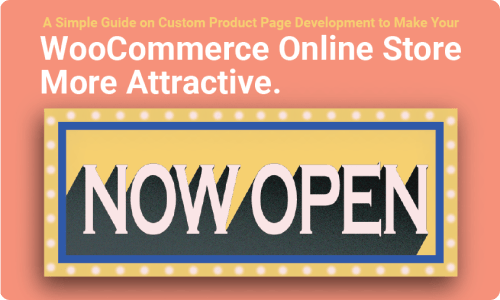When it comes to WooCommerce, store owners want to do everything they can to increase sales, but they don’t always realize that their product pages can be a significant factor. But this is absolutely something you should be considering. Indeed, according to a good friend of ours who owns a WordPress theme company, around 60% of returns aren’t due to problems with the theme. Instead, these are usually due to issues on the site.
So, if your products are spread across multiple pages or have a cluttered and confusing layout, you’re likely going to push away potential customers. Of course, your eCommerce store is only as good as its product pages, but these need to be a goldmine of information to help convert your customers. But creating Google-friendly, conversion-ready product pages isn’t always an easy task, especially if you don’t know where to start. Luckily, you will learn how to do so with this post!
On your business website, your product pages are the most important elements. Why? This is where potential customers decide to either “add” to the shopping cart or “remove” an item from it. And, of course, there’s always the risk of a return if the customer isn’t satisfied with the product they’ve bought. Therefore, these vital pages must always be designed with a focus on helping visitors make an informed purchase.
Using custom styling
In WooCommerce, adding a little bit of custom styling can boost your conversions. The more unique your store and the more photos you have, the higher your conversion rates will potentially be. However, uniqueness isn’t necessarily as simple as adding bold or italic text. Some people like to think of uniqueness as using a light color that’s easy on the eye. Meanwhile, others go for bolder design options.
Many people make one page with a header and then switch to product pages on the other side. Product pages should be fully functional with all the flairs and features a customer might ever need for their products.
WooCommerce uses a color code scheme that helps visitors determine if a product is theirs or someone else’s. The primary colors used are black, purple, red, yellow, and green, with secondary colors for additional variations.
Your stylesheets (or CSS) are the visual cues your web designer uses to compose your website layout. They tell a designer how your site looks and how it should organize content across different pages. Unfortunately, only a handful of the best websites use CSS daily. As such, you should prioritize building your skills with these techniques over learning new things. There are hundreds of free resources online if you need more in-depth instructions. Instead, you should concentrate on practical examples and explanations of a specific technique, such as applying a background image or gradients to a div.
Adding new elements
Do you find yourself adding things to your product pages for no reason? Visitors to your website are skimming through your content and want to find results quickly. There are three ways to deal with this issue: first, you could speed up the loading time for your visitors by avoiding loading images and videos directly onto your page, or if you must use them, use them lower on the page where they won’t interfere so much with initial loading. You can also speed up the time for customers to see your product by preloading an asset the moment they land on your page or adding it as a standalone page, instead of it being an element of existing pages. Or, you could add “additional files.” These include JavaScript, images, and other files that you want to be downloaded and include without executing them on your page.
Building completely from scratch
It is possible to build a complete product entirely from scratch by using the WooCommerce template. With the right technology and just a little creativity, almost anyone can have a web-based store that sells exactly the products they’ve envisioned. Everything from pricing, layout, product images, and even the checkout process can be customized, including product descriptions! This power is often wielded by entrepreneurs who create niche websites that offer special reward programs or otherwise attract niche customers.
Adding a WooCommerce store to your website
Adding a WooCommerce store to your website allows you to sell any product directly from your platform, whether it’s a freshly-made pizza or a multi-million dollar superyacht. This simple feature also allows your customers to buy directly within your website without ever leaving your WordPress site. However, there is one limitation of this method: most WooCommerce plugins only work if the designer has uploaded the exact file you need for the product page.
This is what we mean by “completely custom products.” As such, if you have already built a site with a standard WordPress theme, all you need to do is add the necessary file details and customize your product’s colors and fonts with CSS.
What’s the idea behind WooCommerce?
The idea behind the WooCommerce extension is to provide developers and designers with a simple way to extend the functionality of WooCommerce and add new features very quickly. With the extension, your store can sit reliably on the SERPs, show mobile-friendly storefronts, and offer all kinds of new features (without having to code a single line). In addition, WooCommerce allows you to have multiple stores with separate parts and display the complete product listing for each store in the dashboard. It also allows content creation on the backend (using SPAs) and provides emails with more information about the store’s current sales or promotions.
Designing a custom WordPress product is no simple feat. On the contrary, it’s more difficult than you might expect. So, often, getting started can seem like a daunting task, especially given the number of moving parts involved. But, once you get started, designing your custom product is simply a matter of following a few steps and thinking out loud about what you want the product to do.
Wrapping up
The best way to create a successful online store is to think like a salesperson. First, you need to develop good relationships with your potential customers. That means asking them questions to determine what they need and how they can benefit from your products or services.
Building trust takes time, and it requires communication. However, it’s simultaneously necessary to build your store in a way that encourages repeat purchases.
For further details and queries, feel free to send an email to info@engagebranding.com.



